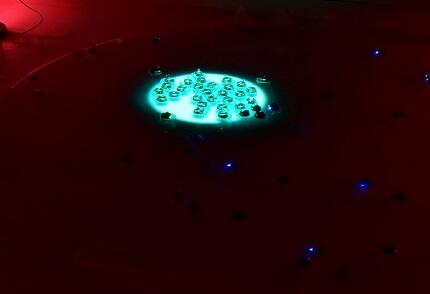Robots able to change their orientation thanks to their morphology
In robotics, swarms of robots are used to accomplish tasks requiring cooperation between several individuals. To date, they operate exclusively in diluted environments, avoiding collisions. Conversely, the flexibility of living organisms(1) suggests that simple primitive behaviors are sufficient to obtain collective behaviors in diluted as well as very dense environments. Based on this observation, researchers from the Institute of Intelligent Systems and Robotics (ISIR, Sorbonne University/CNRS) and the Gulliver laboratory (ESPCI Paris -PSL/CNRS) have studied the physical interactions that can be used to the advantage of a swarm, including those made up of robots. They have designed robots capable of changing their orientation simply by bumping into each other, based solely on their morphology. At the interface between robotics, computer science and physics, their research is the subject of a paper published on February 22, 2023 in the journal Science Robotics.
-
Nicolas Bredeche, professor the Institute of Intelligent Systems and Robotics (ISIR)
-
Olivier Dauchot, research director at the Gulliver Laboratory, CNRS
-
Katherine Tyrka, international press service, Sorbonne University
-
+33 (0)1 44 27 51 05
In this paper, the authors take advantage of a generic mechanical response: the tendency of a particle to reorient itself in response to an external force. They reveal the importance of this morphological response in different robotic tasks, both for a single robot and for a swarm of robots. Their research shows that the way robots respond to collisions depends on their body, and allows them to align themselves with or against an external force such as another robot, an object or a wall. By understanding the effect of physical interactions between robots and their environment, it then becomes possible to define the collective behavior that will result from multiple collisions between robots in the swarm. Depending on the exoskeleton that dresses the robots, we can thus observe that one robot will align itself to an external force while another will oppose it. In case of collision, a robot can push or slide along an obstacle or another robot, and this only thanks to the passive dynamics induced by its mechanical design.
The researchers have also shown that it is possible to learn to exploit interactions between robots to perform collective robotics tasks requiring cooperation, such as collective aggregation in a bright area of the environment. To do so, they describe a decentralized reinforcement learning algorithm inspired by social learning: sufficiently close robots exchange information about the most efficient behavioral strategies to accomplish the task assigned to the robot swarm. In this way, the best strategies are spread from robot to robot, thus making the best use of the physical properties and computational capabilities of the robots in the swarm.
This work was conducted as part of the French National Research Agency project ‘Morphofunctional Swarm Robotics’, by the Institute of Intelligent Systems and Robotics (Sorbonne University/CNRS) and the Gulliver Laboratory (ESPCI Paris - PSL/CNRS). This project involves a post-doctorate and a thesis funded by theSorbonne Center for Artificial Intelligence (SCAI).
[1] Such as cells, colonies of bacteria or ants, schools of fish, flocks of birds or even humans.

Référence :
DOI: 10.1126/scirobotics.abo6140
